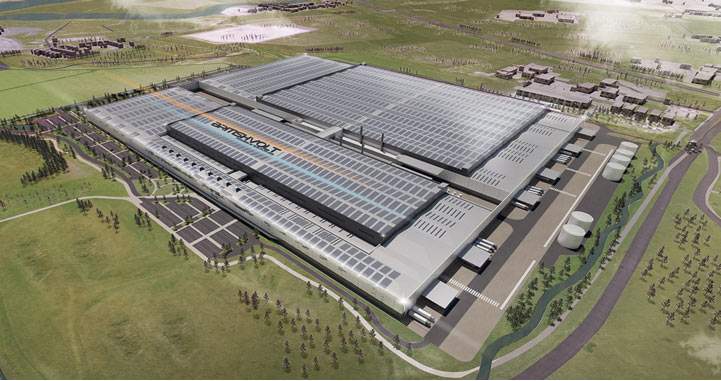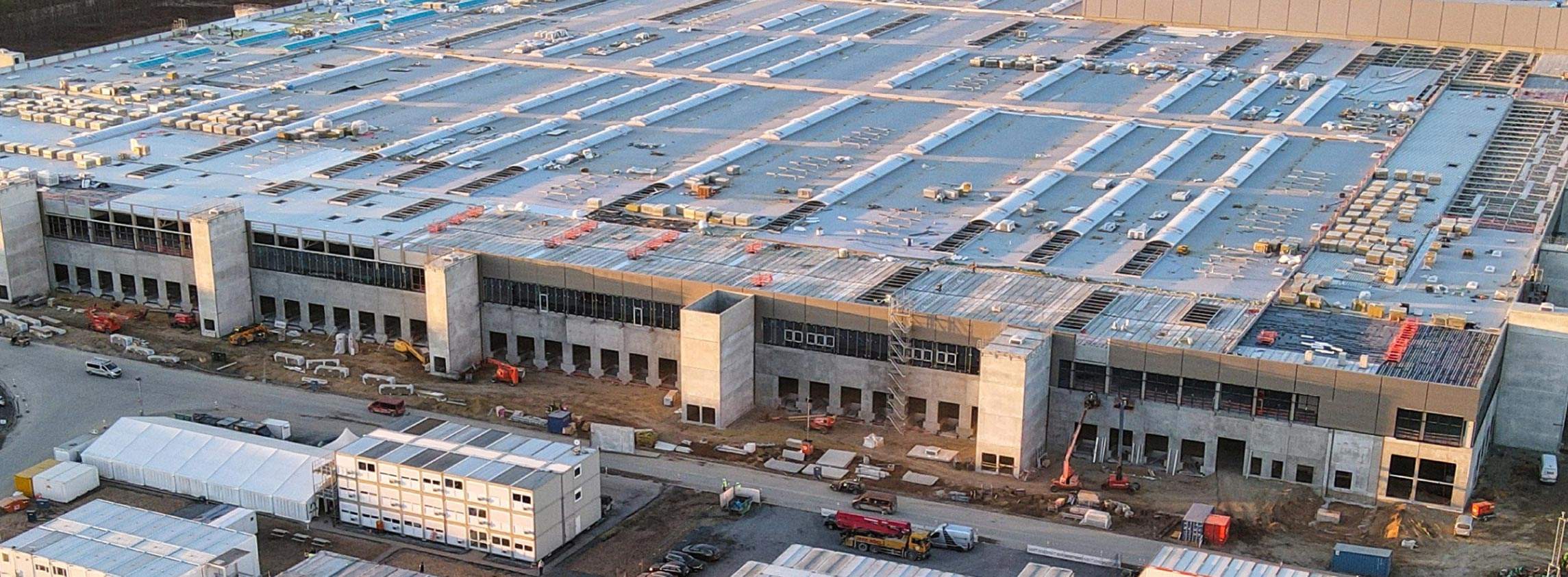What are the implications for the wider industrial property market?
As we have witnessed in many geographies around the UK, manufacturing investment, particularly from automotive and aerospace companies, has resulted in a significant uptick in the take-up of more traditional warehouse take-up in the hinterland of any manufacturing plants. The benefits of agglomeration economics are well understood as suppliers and other complementary manufacturers establish a nearby base in order to feed into just-in-time supply chains.
In the West Midlands for example, where significant investment has been made by JLR, take-up of warehouse space associated with the manufacturing and automotive sector rose by 172% over three years, and 2017 accounted for 51% of all of the warehouse space transacted in the region, accounting for 3.2m sq ft.

Gigafactory development
Based upon estimates from the Faraday Institute, by 2040, the UK can expect to house up to 21m sq ft of space producing batteries alone, and with Britishvolt suggesting a further 2–3m sq ft of warehouse space will be required to support its supply chain, it is fair to assume that over the course of the next 20 years, over 40m sq ft of warehouse space will be required to deliver the batteries the UK automotive industry needs.
Indeed, this ties in with more detailed analysis of employment densities and the amount of space required per each new job. Using the Faraday Institute job growth forecasts, we have been able to calculate the anticipated space requirement for the industry. The Institute expects an extra 83,000 new FTE jobs in the EV and battery manufacturing industry would be supported through the construction of eight Gigafactories.
49.88 million sq ft of warehouse space will be required in order to accommodate any future employment growth resulting from Gigafactory development
Kevin Mofid, Director, Commercial Research
They expect 8,000 new jobs in EV manufacturing (B2), 26,000 in battery manufacturing (B2), 47,000 jobs in the supply chain (B8), and 2,000 in research and development (B1c - which is now E(g)(iii) (England); B1(c) (Wales)).
Using the 3rd edition of the Employment Densities guide published in November 2015 by the Homes & Communities Agency, which pre-dates the Use Class changes of September 2020, we have assumed a density of 60 sq m per job for B1b, 36 sq m for B2 and 70 sq m for a B8 ‘Final Mile’ distribution centre. The above densities highlight that 49.88m sq ft of warehouse space will be required in order to accommodate any future employment growth. Assuming a site cover of 45% by 2040, an additional 2,493 acres of industrial land (B1c, B2 and B8) will be required to meet that need.
In our opinion, this is where landlords and developers of warehouse and industrial space will see the largest benefit, by developing and leasing space to the suppliers of any additional manufacturing plants in the UK.
However, given the challenges and scale of development required, it is anticipated that demand will be volatile and stretched across the next two decades as more manufacturing capacity comes online and the demand for electric vehicles rise.
Should we see Gigafactory development take place in markets such as the North East and South Wales, this has the potential to dramatically alter the supply and demand dynamics in those markets as both regions are comparatively ‘under warehoused’ when compared with other core markets.
Indeed, for units over 100,000 sq ft, South Wales has just 7.7m sq ft of stock, and whilst the North East fares slightly better with 17.2m sq of stock, this pales into insignificance when compared to the Midlands with 200m sq ft of stock.
In South Wales, for example, total warehouse stock would need to increase by 40% should a battery production facility ever be constructed. It is likely that demand and supply would remain out of balance and, therefore, rents would increase ahead of the prevailing forecast levels at the time.
What has been the American experience?
Following Tesla’s incorporation back in 2003, we have witnessed a classic case of growth in line with the theory of technology adoption by Geoffrey Moore, which states that initially, we see limited activity before finally seeing mass-market acceptance. Since Tesla acquired their first factory space in Fremont, California, back in 2010, their growth and impact on the wider industrial and logistics market has been vast.
Whilst the decision to acquire a second-hand factory by Tesla in California was interesting, in many ways it was an opportunistic (and cost-effective) property deal, as GM and Toyota were ceasing production at the facility. Perhaps more interesting has been their subsequent industrial real estate acquisitions, not just because of what Tesla is doing and where they are locating, but also because of the wider impact on the industrial market in the hinterland of the Gigafactory.
The first new facility was a 5.8m sq ft complex – originally built in 2016 and expanded in 2019 – which employs over 7,000 people outside of Sparks, Nevada. The entire complex is set to employ over 10,000 workers and is the primary battery facility for Tesla’s current vehicles, which are manufactured at their Fremont plant. According to the Nevada governor’s office, an additional 8,200 local jobs have been created due to Tesla having operations in the area. Since the complex was first announced in 2015, the impact on the wider Reno industrial and logistics market has been huge. Indeed, since 2015, the vacancy rate in the market has fallen from 10.4% to 4.4%, and average rents have risen from £2.92 per sq ft to £4.96, a rise of 70% over six years.
During the same period, average take-up levels have risen to 7.9m sq ft per year, whereas pre-2015 take-up averaged 4m sq ft per year. In terms of warehouse construction, this has also seen a dramatic rise since the 2015 Tesla announcement. Development completions now stand at 3.7m sq ft per year, up from 1.4m sq ft per year.
In the summer of 2020, Tesla announced a new 4.5m sq ft complex will be built in Austin, Texas, with the aim of completing in late-2021. The facility, when completed, is expected to employ over 10,000 people on a 2,100-acre site and will be the primary factory for the Tesla Cybertruck and the Tesla Semi, as well as producing Model 3s and Model Ys for the eastern US states.
Whilst it is little over 18 months since the initial announcement, and vehicle production is yet to start, the impact on the wider industrial and logistics market has been quick and noticeable. In a little over 12 months, the market vacancy rate has fallen from 6.2% to 3.4%; construction deliveries have risen to their highest ever level of 6.1m sq ft, and achieved rental levels have seen their largest ever single-year increase to now stand at £7.67 per sq ft, a rise of 18% in just 12 months. As production increases and more of Tesla’s suppliers start to locate nearby, we can expect to see demand for warehouse space increase which, in turn, should see vacancy fall and rents continue to rise.
Examining detailed data on the labour market in both Reno and Austin also paints an interesting picture. Looking at job postings shows a wide variety of roles being required, from production line workers through to hardware and software engineers.
However, in more recent times, it has been reported that Tesla has been struggling to hire in and around Reno, which in turn has the potential to see wages rise in order to attract and retain the best talent. This, in turn, has had a wider impact on the residential market, with house prices in Reno rising 42% two years after the announcement, according to ATTOM Data Solutions.
Whilst it is difficult to entirely isolate the Tesla impact, given the wider trends in the industrial and logistics market, it is clear the Gigafactories are massive economic development engines which have amplified activity in the wider industrial markets of which they sit.
Gregg Healy,
Executive Vice President,
Head of Savills Industrial Services, North America
Read the articles within Spotlight: Gigafactories below.


